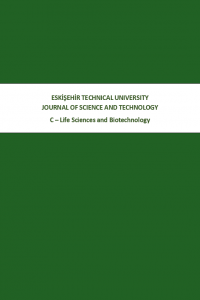ENDEMİK HEDYSARUM CAPPADOCICUM BOISS. (FABACEAE) TÜRÜNÜN ANATOMİK ÖZELLİKLERİ
Bu çalışmada Hedysarum cappadocicum türünün anatomisini ortaya koymak amaçlanmıştır. Hedysarum cappadocicum türü İç Anadolu ve Doğu Anadolu’da yayılış gösteren endemik bir türdür. Bu çalışmadaki örnekler Sivas ilinden toplanarak türün tanımı yapıldıktan sonra kök, skapus, petiyol ve yaprakçıkların anatomileri araştırılmıştır. Türe ait anatomik özellikler detaylı bir şekilde ilk defa bu çalışmada ortaya konulmuştur. Anatomik çalışmalar sonucunda türün kök enine kesitinde sekonder yapı, skapus enine kesitinin çıkıntılı oluşu, tanin içeren izobilateral ve amfistomatik yaprakçıklar, üç köşeli petiyol ve anizositik stoma tipleri tanımlanmıştır.
Anahtar Kelimeler:
Anatomi, endemik, Hedysarum cappadocicum, Türkiye
ENDEMİK HEDYSARUM CAPPADOCICUM BOISS. (FABACEAE) TÜRÜNÜN ANATOMİK ÖZELLİKLERİ
The aim of this study was to describe the anatomy of Hedysarum cappadocicum. The species of Hedysarum cappadocicum is an endemic and distributed in Central Anatolia and Eastern Anatolia. The samples of this study were collected from the province of Sivas after the description the anatomy of the root, scapus, petiole and leaflets were investigated. The anatomical features of the species have been compared with the results of previous investigations. The anatomical features of the species are presented in this study for the first time in detail. The results of the anatomical study described that the species have secondary growth in cross-section of root, ribbed structure of cross-section of scapus, isobilateral and amphistomatic leaflets with tannin, triangular shaped petioles and anisocytic stoma type.
Keywords:
Anatomy, endemic, Hedysarum cappadocicum, Turkey,
___
- Reference 1 Simpson MG. Plant Systematics. 1. Edition. Elsevier-Academic Press, New York, 2006.
- Reference 2 Güner A, Aslan S, Ekim T, Vural M ve Babaç MT. (edlr.) Türkiye Bitkileri Listesi (Damarlı Bitkiler). Nezahat Gökyiğit Botanik Bahçesi ve Flora Araştırmaları Derneği Yayını, İstanbul, 2012.
- Reference 3 Pharmacopoeia of the People’s Republic of China 2005 (Set of 3, Chinese edition) Publisher: Stationery Office.
- Reference 4 Hai LQ, Liang H, Zhao YY & Du NS. Studies on chemical constituents in the root of Hedysarum polybotrys. Zhongguo Zhong yao za zhi= Zhongguo zhongyao zazhi= China journal of Chinese materia medica, 2002; 27(11): 843-845.
- Reference 5 Liu Y, Zhang QY, Zhao YY, Li-Qian Hai BW, Ying YP, Chen HB. Saponins from the roots of Hedysarum polybotrys. Biochem Syst Ecol 2007; 35: 389-391.
- Reference 6 Liu Y, Zhao YY, Tu GZ, Chen HB. Flavonoids of the roots of Hedysarum kirghisorum, Biochem Syst Ecol 2005; 33(8): 809-812.
- Reference 7 Civelek S, Yaman A, Sahin A, Gur N. The investigation in point of chromosome number, morphological, anatomical and pollen characteristics of Hedysarum aucheri Boiss. Jou Sci Eng Fırat Univ 1999; 11: 77–88.
- Reference 8 Dural H, Yılmaz Cıtak B. Morphology and anatomy of Hedysarum pannosum (Boiss.) Boiss. (Fabaceae). Acta Bot Croat 2015; 1:19-29.
- Reference 9 Karnaukhova N A. Anatomo-Morphological Features of the Leaves of Hedysarum theinum (Fabaceae) in Western Altai. Contemp Probl Ecol 2016; 9(3):349–354.
- Reference 10 Ranjbar M, Hajmoradi Z, Karamian R. The taxonomic importance of leaf epidermis morphology and peduncle anatomy in Trigonella disperma Bornm. ex. Vassilcz. TBJ 2010; 1: 15–26.
- Reference 11 Güvenc A, Hürkul M M, Erdem A. The leaf anatomy of naturally distributed Juniperus L. (Cupressaceae) species in Turkey. Turk Jou Bot 2011; 35: 251–260.
- Reference 12 Davis P H. (ed.) Flora of Turkey and the East Aegean Islands. Vol. 3, Univ.Press, Edinburgh, 1969.
- Reference 13 Davis A P, Barnett J R. The leaf anatomy of the Genus Galanthus L. (Amaryllidaceae J. St.-Hil.). Bot J Linn Soc 1997; 123: 333–352.
- Reference 14 Jensen WA. Botanical Histochemistry: Principles and Practice. W.H. Freeman and Company, 1962.
- Reference 15 Hedge IC. Hedysarum — In: Davis P.H. (ed.), Flora of Turkey and the East Aegean Islands, Edinburgh University Press, Edinburgh 1970; 3: 549–560.
- Reference 16 Metcalfe CR., Chalk L. Anatomy of the Dicotyledons I., Oxford: Clarendon Press 1957. pp. 504–516.
- ISSN: 2667-4203
- Yayın Aralığı: Yılda 2 Sayı
- Başlangıç: 2010
- Yayıncı: Eskişehir Teknik Üniversitesi
Sayıdaki Diğer Makaleler
SALİX FRAGİLİS L. (GEVREK SÖĞÜT)’ İN AĞIR METAL KİRLENMESİNDE BİOMONİTÖR OLARAK DEĞERLENDİRİLMESİ
BİTKİSEL KAYNAKLI BAZI DOĞAL ANTİMİKROBİYALLER
İlkin Yücel Şengün, Berna Öztürk
ENDEMİK HEDYSARUM CAPPADOCICUM BOISS. (FABACEAE) TÜRÜNÜN ANATOMİK ÖZELLİKLERİ
Seval Cing Yıldırım, Turgay Kanat
SULARDA BULUNAN UÇUCU ORGANİK BİLEŞİKLER VE SAĞLIĞA ETKİLERİ
Barış GÜZEL, Oltan CANLI, Elmas ÖKTEM OLGUN
ELEKTRO-OKSİDASYON PROSESİ İLE BİYOLOJİK ÇAMUR DEZENTEGRASYONU
